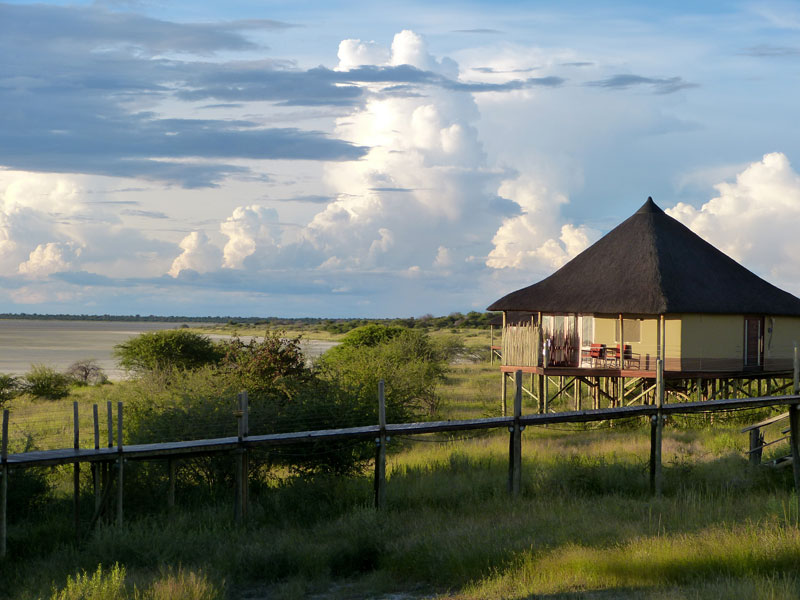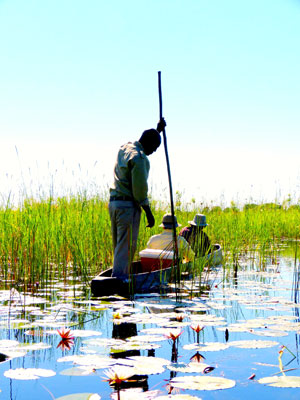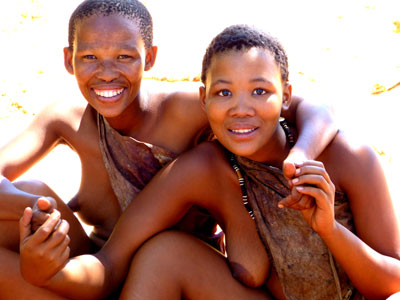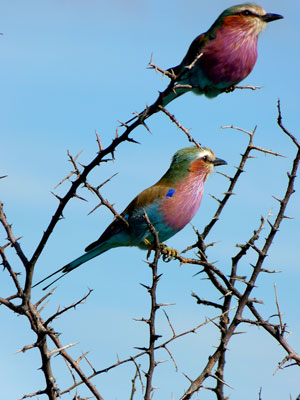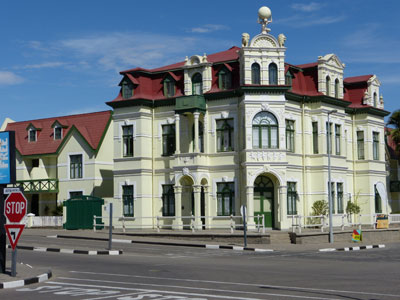From wildlife to waterfalls, enjoying a small-group adventure in Southern Africa
This article appears on page 6 of the October 2014 issue.
by Yvonne Horn, Contributing Editor
Over the span of a year or so, a number of travel articles about Namibia tickled my travel radar. So when I received an invitation from ElderTreks — with whom I had traveled twice before (Ethiopia, Aug. ’07, pg. 6, and Iran, July ’09, pg. 24) — to participate in an upcoming tour, I jumped at the chance.
Their “Splendors of Africa” itinerary devoted a full 17 of its 25 days to Namibia before continuing on to Botswana and Zimbabwe, the latter's thundering Victoria Falls providing the grand finale.
Beginning in Windhoek
Teeth gritted for the excruciatingly long flight from my San Francisco home-base airport to New York City (on United), then on to Johannesburg, South Africa, and, finally, Windhoek, Namibia (on South African Airways), I arrived some 24-plus hours later and a day earlier than the trip’s mid-March 2014 departure date. This gave me a day on my own to explore Windhoek, Namibia’s capital — a city that I quickly discovered offers more than a nod to its German heritage, with clean-swept, orderly streets and its array of 19th-century buildings, albeit interspersed with modern, soaring architecture.
Germany, a relative latecomer to the great scramble for pieces of Africa, founded a military post at Windhoek in the 1880s as a center for expansion. In short order, Namibia was annexed as a territory and remained so until, during the course of World War I, the former colony became a South African mandate. German settlers, however, were allowed to stay, and German remained the territory’s official language.
After the country’s independence was achieved in 1990, Afrikaans became the language of the land (though English is the “official” language of Namibia), but, as was evident in Windhoek and later throughout our 17 days crisscrossing the country, the legacy of German colonization remains intact throughout Namibia.
In the seaside town of Swakopmund, many Jugendstil (Art Nouveau) buildings remain, and in the vast agricultural area of Grootfontein in the north, suceeding generations work the land claimed by their colonial ancestors.
That evening, with all group members having arrived, we assembled on the veranda of Villa Verde Guesthouse, our Windhoek hotel.
About the tour
ElderTreks specializes in small-group adventure travel designed for people 50 and over. On this trip there were eight of us, ranging in age from early 60s to a nimble 88. With two trips with this company under my belt, I felt like an experienced ElderTreks traveler, until I learned that all were repeat travelers, with one group member logging this as trip number 25!
Two guides — Duane Rankin, a longtime ElderTreks’ tour leader, and Matt Kotzé, the trip’s national guide — would see us through our adventure. Both stepped into the journey with decades of experience and knowledge guiding travelers through their African homeland.
I was astounded, when we gathered for departure the following morning, to discover that our small group would be traveling on a 32-passenger bus!
ElderTreks’ brochure told us to expect long drives in Namibia. As our trip proceeded, what had appeared to be an overkill mode of transportation made sense, as it allowed us to sit high, and each of us enjoyed a window-seat view, turning the long drives into trip highlights.
Road conditions also made the bus, which provided a comfortable ride, a fine choice. Of the country’s network of more than 42,000 kilometers of roads, fewer than 6,000 kilometers are paved. Add to that potholes and washouts plus the occasional cattle and wild game ambling ahead.
On mornings after a heavy evening rain, we were alerted to the possibility that flooded areas along our planned route might result in a long circling back. More than once, Duane and Matt jumped out, shoes off and pants rolled up, to gauge the water depth. Invariably, Zebald Hangero, our affable and able driver, throttled our high-base bus through.
Interesting stops
While it would be impossible to cover the entirety of Namibia’s 318,258 square miles (twice the size of California) in 17 days, ElderTreks’ itinerary was designed to show us that there was far more to this country than a vast desert.
Our first destination was Sossusvlei Dunes in the Namib Desert. Dating back 55 million years, it is the world’s oldest desert. With our alarms set for a before-dawn departure, we arrived in time to catch the morning light bathing the dunes in a symphony of colors — lavender, pink, apricot, coral and terracotta.
Climbing is allowed on only a few of the awe-inspiring dunes. The hardiest amongst us took on Dune 45, clambering through the sand to its top, more than 550 feet above the plain.
Ever-changing landscapes in the days to come took my breath away, from the canyons and rugged mountains of the Namib-Naukluft National Park (at 19,200 square miles, it is bigger than Switzerland) to the stretch of wild Atlantic shore known as the Skeleton Coast, so named for the deadly shipwrecks, caused by its treacherous waters, dating back to 15th-century Portuguese explorers.
Stops along the way were diverse, ranging from the enormous breeding colony of Cape fur seals at Cape Cross to Twyfelfontein’s collection of more than 2,000 rock engravings and paintings dating to before 3300 BC.
Equally interesting were impromptu side-of-the-road stops. Pausing in the rocky mountains of the Naukluft range to stretch our legs and take in the view, we were astonished to learn that among the pebbles underfoot were garnets, there for the picking, graphically illustrating that in addition to Namibia’s richness in diamonds, there was an array of other gemstones, plus ultrarich deposits of uranium, lead, zinc, tin, silver and tungsten.
At another stop, Matt took us to a quiver tree, so named, Matt explained, for the hunting San tribe’s traditional use of the tree’s hollowed branches as quivers to carry their arrows.
Jörn Gressmann, owner of our game-farm accommodation Fiume Lodge, outside Grootfontein, took us to meet the San people. Jörn, who fluently speaks the language, translated while the small, lean people known for their remarkable tracking skills graciously demonstrated their way of life. (Interestingly, we learned that “Bushmen” is not considered a derogatory term for the San.)
The local guides also took us to other tribal villages, with those in Damaraland being the most memorable. There we visited the Himba, whose everyday dress consists of very little. The women are known for covering every inch of their bead-decorated bodies, including their hair, with a mixture of butter fat and ochre.
Zemba women, like the Himba, also wear very little, but they stop short of the use of ochre. Both the Himba and the Zemba tribes are subsets of the Herero people.
In sharp contrast, the everyday garb of Herero women is traditional Victorian-era dress, as introduced by German missionaries.
Searching for game
Throughout our journey we were treated to comfortable weather, thanks to a delayed rainy season that extended further into 2014. With evening rainfalls, entire flowery carpets seemed to pop up overnight.
Fat and glossy cattle munched on the abundant greenery — along with an occasional exotic creature (“Giraffe on the right!”). With that, I was looking forward to our safari excursions through what is known as “the jewel in Namibia’s wildlife crown,” Etosha National Park.
There we found a bit of a downside to the late rainy season. Abundant greenery and water in the veldt made it unnecessary for animals to wander down to the man-made and natural water holes along Etosha’s safari routes.
Man-made water holes located but steps away from our Okaukuejo Camp and Namutoni Camp accommodations ordinarily attract an extravagant peaceable kingdom of animals for safe and quiet viewing, but both remained empty during our stay.
Thanks to Daniel, our 4x4 driver/guide, we logged sightings of an amazing number of Etosha’s 114 wild mammal species, the great herds of zebras, giraffes, impalas, kudus and springboks soon becoming ho-hum. Our rarest sighting was an archaic beast on the endangered list: a black rhinoceros.
Having about given up on spotting lions, we rounded a curve to find a pair mating by the side of the road, the male ending with a mighty roar.
On our last day in Etosha, elephants remained on our “want to see” list. Minutes away from our lodging at Onkoshi Camp, Daniel spotted one in the bush. Its giant ears flapping, it came closer and closer and closer yet, Daniel carefully measuring the distance before declaring, “Time to get out of here!”
Accommodations
Lodging during our 25 days together ranged from comfortable to downright luxurious. The three Etosha lodges, all Namibia Wildlife Resorts properties, were standouts, with Onkoshi Camp especially notable.
Onkoshi’s 15 permanent tents, set on stilts, overlooked the great salt pan that covers 25% of Etosha’s surface and gives it its name, the Great White Place. Boardwalks connected the tents to a large-tent dining and bar area. A connecting deck held a small infinity swimming pool stretching seamlessly into the pan.
Rooms cleverly separated into different areas — using stalks of bamboo to create walls — featured wide window-doors opening to private decks. Interiors offered 5-star amenities.
We ate well throughout our journey, with breakfast, lunch and dinner included daily. Carnivores will have a field day in this corner of the world, as menus featured cuts from many of the animals we’d seen on safari, including kudus (especially delicious), oryxes, ostriches, elands and springboks. Add to that beef, from the free-ranging sleek and fat cattle that we encountered being watched over by lonely herdsmen throughout our travels.
Lunches were picnics, usually consisting of several salad choices, cold cuts and breads, served during rest stops by the edge of the road. Duane and Matt would set up, like magic, tables, chairs and tableware, with a pot put on to boil for tea.
On to Botswana
Next on our itinerary of adventures was Botswana’s Okavango Delta, with some 10,000 square miles of papyrus swamps, tall rushes, water lily-carpeted lagoons, palm tree-fringed islands, floodplains and narrow waterways.
Our bus delivered us to a scheduled side-of-the-road stop, where we said good-bye to Zebald, who would meet up with us three days later. A 4x4 vehicle was waiting to take us to our next accommodation, Nguma Island Lodge.
Our permanent tents at this lodge were not of Onkoshi Camp’s level of luxury, but each was airy and spacious, with a screen door separating an open-to-the-sky shower, toilet and sink area. A cautionary note alerted me to not leave anything in the bathroom, as it might be stolen by monkeys.
Boardwalks, lined by lush, jungle-like foliage on either side, connected the tents to the log-structure dining, bar and lounge area, its wide deck overlooking the lagoon.
For three days we explored the delta’s waterways in mokoros. Each canoe propelled skillfully by a pole, we sat alarmingly low in the water, two to a canoe, as we skimmed soundlessly through the crystal-clear, lemon-lime water. Traditionally, mokoros were crafted from tree trunks hollowed out with fire and a small hatchet. Today’s vessels are made of fiberglass, the old ones seemingly relegated to decorating lodge entrances.
We were warned not to fidget and to never ever stand up or be tempted to drag a hand through the water, as crocodiles abound. A menagerie of other wildlife can also be found in the delta, but the animals were not readily seen because of the late-running rainy season. Instead, we delighted in the birdlife that makes the Okavango a bird-watcher’s paradise and in the flowering plants that brushed the edges of our mokoros.
We did spot hippos, from which our guides kept a careful distance. Listed among the most dangerous of animals, a hippo is able to hold its breath for an amazingly long time under water, and they have been known to cause disastrous instances of mokoros being tipped over.
Chobe National Park
On the day of our departure from Botswana, we were delivered to a long, grassy strip to await the arrival of the 12-seater Cessna that would fly us over the Okavango to the airport at Kasane, located on the delta’s far-eastern side. There, Zebald and our bus waited to take us for a 2-night stay in Chobe National Park.
Located at the confluence of two major rivers, the Chobe and the Zambezi, the park is home to huge herds of game. Early-morning and evening safaris on sand roads followed the course of the river into the woodlands. In contrast to those at Etosha, Chobe’s routes felt crowded — too many safari vehicles on too few roads — even with a 3-hour limit imposed at the gate.
An early-morning safari came up empty until a gathering of vehicles alerted us to something going on ahead. Three female lions and their playful cubs came sauntering out of the bush and paused in the road, the little ones rolling and scampering about.
Seven vehicles jockeyed for position as the king of the beasts strolled onto the scene. “Everyone wants to see cats,” our driver/guide sighed. Yes, that included us.
Late-afternoon outings treated us to herds of elephants gathered in the wallow, rolling in mud, trumpeting and spraying themselves with trunks filled with water, all in the company of an impressive display of snorting water buffalo.
During a sunset cruise on the river, Duane provided chocolate cake and tea for an, oh-so-civilized treat as hippos harrumphed and opened their jaws wide around us and the oncoming evening’s golden light, framed by dark trees, turned pinky-purple.
From Chobe, we entered Zimbabwe’s Victoria Falls National Park for the grand finale of the trip, the falls’ mile-wide curtain of water, one of the Earth’s natural wonders. While it was possible to rent a poncho to wear while walking the path along the edge of “The Smoke That Thunders,” it was most fun to emerge from its drenching mists soaked to the skin. Completely immersed — a fitting finale to our 25-day immersion in the splendors of Southern Africa!
Yvonne Horn was a guest of ElderTreks (Toronto, Canada; 800/741-7956, www.eldertreks.com), which covered the cost of the land portion of the tour. ElderTreks’ 25-day “Splendors of Southern Africa” costs $8,995 per person, double, including all meals and hotels, locally guided tours, an interior flight, a Zimbabwe visa and all gratuities (except for those for the trip leaders). Departures are scheduled for March 13 and Sept. 18, 2015.

